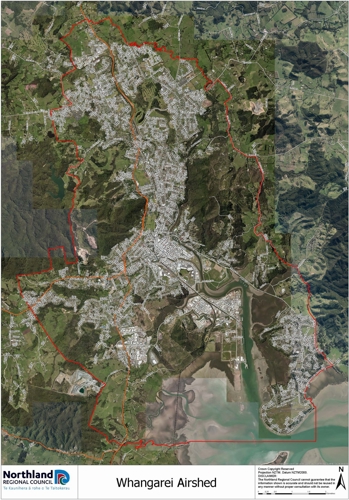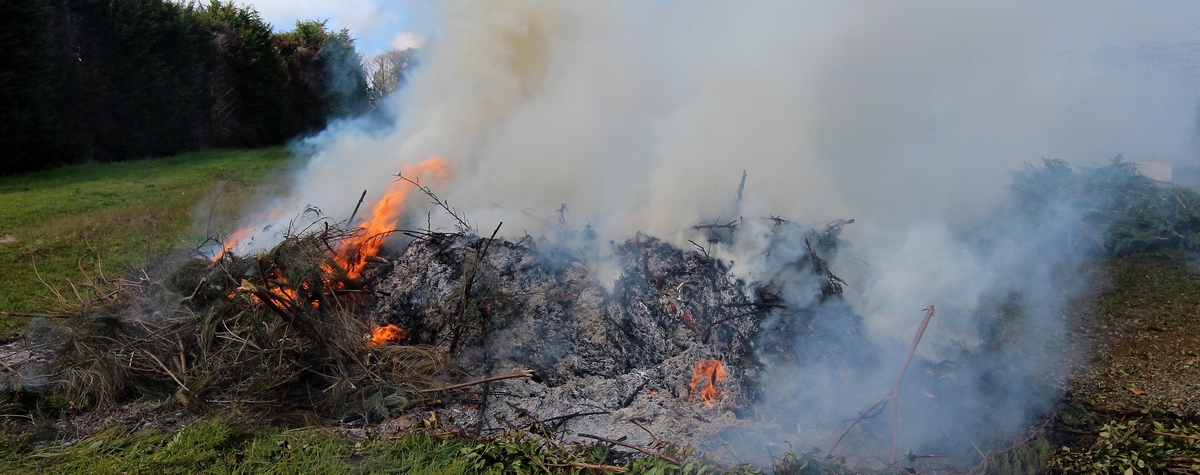Autumn burning prompts reminder of rural, urban rules
9 Apr 2021, 8:28 AM
Northlanders planning to burn unwanted waste material this autumn are being encouraged to consider their neighbours and follow the rules, or risk fines and other penalties.
 The Whangarei airshed – pictured – is roughly bordered by Kamo, Raumanga, Maunu and Onerahi.
The Whangarei airshed – pictured – is roughly bordered by Kamo, Raumanga, Maunu and Onerahi.
Burning and smoke nuisance complaints make up 25 percent of all incidents reported to the Northland Regional Council (NRC) Environmental Hotline, says Councillor Joce Yeoman, who chairs the council’s Planning and Regulatory Working Party.
“They are the most common problem raised via the hotline, and autumn is a busy time of year for backyard fires. People might be burning off vegetation that was left to ‘die and dry’ over summer, or disposing of paper, cardboard or untreated timber. So they need to keep a few things in mind as they tidy up before winter kicks in.”
Nationally, it is prohibited to burn tyres, coated metal wire and oil (in the open air). Most importantly, materials such as plastic containers, treated timber, demolition waste and synthetic materials cannot not be burned. In Northland without a resource consent, only burning untreated wood, paper, cardboard or vegetation is allowed – and this still needs to be managed to minimise the effects on neighbours.
“Smoke from outdoor burning pollutes the air and can cause serious health problems. In particular, burning plastic emits toxic, unpleasant fumes – and frustratingly, it still happens in Northland,” says Cr Yeoman.
Broadly, rules for backyard burning fall into two geographical categories. Outside the Whangārei urban area, Northlanders can light outside fires if they follow certain rules:
- Avoid causing offensive, objectionable or noxious smoke or odours to neighbouring residents.
- At least 24 hours before the fire, notify (in writing) all neighbours within 100 metres if the fire will last for more than 24 hours and is within 100 metres of a smoke-sensitive area (such as homes, schools, parks or marae).
- Don’t obscure vision along a public road.
- Only light fires containing waste that is created on site, and consists of paper, untreated wood, cardboard and vegetation (or animal remains where the burning is on agricultural land).
The ability to have outdoor fires does not apply when there’s a restricted fire season or fire ban in place. Fire restrictions and permits are managed by Fire and Emergency New Zealand. However, anyone who has a permit must still follow the council’s rules, says Colin Dall, NRC’s Group Manager – Regulatory Services.
“People living within the Whangārei airshed – which is roughly bordered by Kamo, Raumanga, Maunu and Onerahi – can only burn waste outdoors if they live on a property one hectare or larger,” says Mr Dall.
They also need to stick to the following rules:
- Only burn untreated wood, paper, cardboard, or vegetation.
- Ensure you do not cause offensive, objectionable or noxious smoke or odours to neighbouring residents.
- Do not burn during June, July or August, when air quality is impacted due to an increase in wood and coal fires for indoor heating.
- Choose weather conditions that will avoid smoke becoming a nuisance.
- At least 24 hours before the fire, notify (in writing) all neighbours within 100 metres of the fire if it will last for more than 24 hours and is within 100 metres of a smoke-sensitive area (such as homes, schools, parks or marae).
Burning for cooking – including BBQs, hangi, pizza ovens or umu – is permitted, as are wood-fired kilns and in some cases community bonfires, but people must not cause smoke or odours that are a nuisance outside their property.
Mr Dall says there are plenty of alternative ways to dispose of waste, whether people are in rural or urban areas.
“Compost, mulch or chip your garden waste, and add it to your garden for extra nutrients. Larger logs can be cut to size and used as firewood during winter,” he says, adding that waste vegetation produces significantly less smoke when it’s been left to dry before burning.
“Dispose of your waste through your district council’s roadside collection, or take larger quantities of refuse to a transfer station. Consider hiring a mini-skip with a neighbour to cut costs while disposing of your waste material. Plastics, paper, glass and tins can go into your recycling bin.”
Over the past five years, there have been an average of 252 burning and smoke nuisance complaints per year. Those breaching the rules are liable for enforcement action, which can range from instant fines of up to $1000, abatement notices and prosecution – the latter with the risk of much stiffer penalties – through the courts.
Anyone wanting to report nuisance or illegal burning can contact the council’s 24/7 Environmental Hotline on (0800) 504 639.
Full information on the rules around backyard burning – including a more detailed map of the existing Whangārei airshed, and a link to rules under the Proposed Regional Plan – is available from the council’s website: www.nrc.govt.nz/backyardburning

Over the past five years, there have been an average of 252 burning and smoke nuisance complaints annually.
